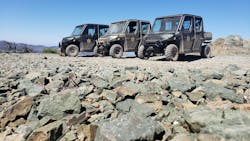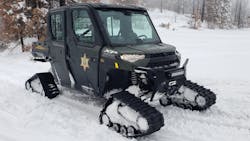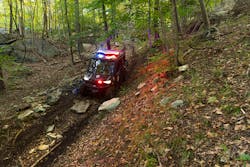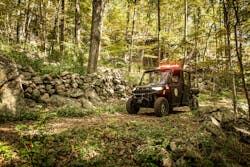On March 6, 2021, the Glenn County Sheriff’s Search and Rescue Team in Northern California responded to a call that lasted most of the day and ended with the successful rescue of nine people. Two vehicles were reported stuck in the snow with seven people inside near the Plaskett Meadows Campground at the Mendocino National Forest. The call went out, and the rescue team members quickly responded in heavy snow conditions. Tracked side-by-side UTVs were used to gain access to the area
This article appeared in the September issue of OFFICER Magazine. Click Here to view the digital edition. Click Here to subscribe to OFFICER Magazine.
The team eventually spotted several sets of footprints in the fresh snow, leading from the direction of where the vehicles were reportedly stuck. The two side-by-sides followed the footprints to investigate and located three individuals from the stranded party, about 10 miles from the vehicles. They had been stuck since 2 p.m. the previous day with no food or water. When the first vehicle became stuck, they called an acquaintance to help them get out. The second vehicle arrived and quickly became stuck as well. During the process of this rescue, a third vehicle that had also been called to help also got stuck in the snow, adding two more individuals to the rescue list. Over the course of several hours, the search and rescue team was able to safely escort the individuals and their vehicles to safety.
“It was totally inaccessible to get there by any four wheel drives we had. So, we used the side-by-sides with the tracks systems on them and they got us there quick without any issues,” Sgt. Jon Owens, who coordinates the Glenn County Sheriff’s Search and Rescue Team, tells OFFICER Magazine. “It wouldn’t have been possible without those side-by-sides to do that. They were definitely used to all of their capabilities.”
Just one year earlier, the Glenn County Sheriff’s Office worked with MacGyver Solutions to add their first Polaris UTVs to their fleet. The three RANGER Crew XP Northstar edition UTVs came equipped with Polaris Ride Command, which features GPS mapping on a seven-inch touchscreen, along with Group Ride connectivity to plan, track and share ride routes enhancing terrain mapping and team communication.
Going off-road
Tony Stanley from Polaris Government & Defense recently spoke to OFFICER Magazine about how UTVs can play a big role in search and rescue operations in remote areas; reaching areas that SUVs and pickup trucks can’t get to. “Our vehicles are smaller and more nimble and that allows them to go into areas that are muddy, boggy, or even snow covered,” he says. “Our vehicles are also a lot lighter. The average F-150 weighs between 4,000 and 5,000 pounds. A Ranger crew model is about half that. They are able to get into these locations without sinking into the mud where maybe a larger, heavier vehicle cannot.”
Stanley stressed that the goal of course is not for a UTV to take the place of an SUV or a truck, but to augment a law enforcement agency’s fleet. “We’re providing them another way out into these remote locations,” he says. “We would like to get them as close to that person needing aid as we possibly can. Time is of the essence. Beyond the Pavement UTVs can access terrain pickups and SUVs can’t and can even be outfitted to take on heavy snow. If someone has a medical emergency, if we can get there a lot quicker via a vehicle, we might get there in time to administer aid before they get much more seriously injured.”In order to transport the UTVs to a place where they are needed, some departments will purchase an open trailer that can be pulled behind a pickup truck or SUV, or an enclosed trailer that doubles as their storage. “These UTVs are light. You don’t need a heavy-duty trailer to transport them. Our heaviest UTV is still only 2,300 pounds, so that’s easily pulled behind even a midsized SUV or a base pickup truck. So, they are easily transported to these remote locations so they can unload them and get after it quickly.”
He adds that most people think of UTVs as being utilitarian in nature, but that they are very comfortable vehicles to ride in. “Officers may be patrolling for 8 to 10 or 12 hours a day in them,” he says. “They are a dream to ride in, the suspension is phenomenal. We’ve got comfortable seats. You don’t think of those things all of the time. These are very comfortable to ride in, reducing the fatigue of officers as they have to patrol on a long shift.”
A year-round vehicle
“We’re a very rural county,” says Owens. “We consist of rice fields, nut trees and the national forest is on our far west side, which is where we’ve used the Polaris UTVs the most. We’ve used them on multiple searches as well for looking for evidence for crimes in rural areas. They have a mapping system that really helps out that came equipped with the ones that we purchased.”
Prior to purchasing the Polaris side-by-side UTVs, the agency wasn’t able to get to a lot of the places they are able to get to now and had to heavily rely on outside agencies from surrounding counties and their equipment, according to Owens. When the snow has melted in the spring, the agency will remove the tracks from the UTVs and use them in orchard fields when homicides and other crimes have been committed. The Ride Command mapping system is able to show where each unit is driving, which helps for the purposes of evidence. “Being able to upload that and use that for court purposes, the evidentiary value is huge,” he says.
The Group Ride feature also comes in handy, allowing the units to be able to communicate with each other. “You can see where your partner is at. If you are driving all three of them, everybody knows where each other are and they can systematically search.”
Training on UTVs
Polaris has a staff of trainers that can go out to a given location and train members of a law enforcement agency on their newly purchased vehicles. The program is customized for that department. “We’re coming out to their location, so we don’t want to train somebody on how to drive in the snow if they are in Arizona. We’re going to use their vehicles, use their terrain,” says Stanley. “Certainly, the surroundings and the terrain (are important). You have to be well aware of the condition so that you don’t break down. There’s that awareness that you’re operating carefully. You’re doing nobody any good if you get a flat tire or you break down in these conditions.”
Owens says that the training on the UTVs in Glenn County usually takes a full day depending on the type of terrain. The first part of the training is to teach the basic functions of the vehicle. When to use low range, when to use high range and the basics of how the piece of equipment works. “The low/high range thing is very important because if you drive those things around in high range at low speeds, you will burn the belt up real quick,” he says. “It has happened where we have burned a belt out. That’s a couple hundred bucks each time that happens.”The next part of the training happens in the Mendocino National Forest where the member of the search and rescue team are taught winching. “Each one of those vehicles are equipped with a winch, so they’ll go through a winching class which is usually a couple of hours just to get the understanding and the mechanics of the winch, when to use it and how to use it,” he says. “Generally, we’ll try to fit this into a day or a weekend of a training as we get new members who need to be trained on it. We’ll invite all members during that training just to refresh themselves.”
Owens says that proper training is necessary in order to operate the UTVs and that lacking the proper training can lead to uneccessary repairs to the units.
A multi-function tool
Two years ago, the KIMTEK Corporation released it’s Leolite line of skids, built specifically for law enforcement agencies. The line includes features like lock boxes for firearms and attachable crates for K-9s. It’s a customizable system that allows for extra seats or a patient carry system.“The Leolite puts together a whole bunch of options to what a law enforcement agency feels they might have to deal with,” says Kimball Johnson, Founder and President of the Vermont-based company. “The possibilities are endless. Let’s say we have an escaped convict who is out in the woods when I have to deploy law enforcement assets out there quickly. These units are built to do that safely and effectively getting them out and getting the K-9s and their handlers out there.”
Law enforcement agencies can purchase the Leolite base, and then add on accessories like K-9 boxes, seats and patient carries. The officers using the UTVs then have the ability to snap in and snap out what they need while in the field. “Within two to three minutes they can make those different combinations happen,” says Johnson.
This article appeared in the September issue of OFFICER Magazine.
About the Author
Paul Peluso
Editor
Paul Peluso is the Managing Editor of OFFICER Magazine and has been with the Officer Media Group since 2006. He began as an Associate Editor, writing and editing content for Officer.com. Previously, Paul worked as a reporter for several newspapers in the suburbs of Baltimore, MD.





